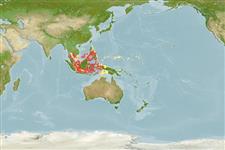>
Ovalentaria/misc (Various families in series Ovalentaria) >
Opistognathidae (Jawfishes)
Etymology: Opistognathus: Greek, opisthe = behind + Greek, gnathos = jaw (Ref. 45335); to the very elongate upper jaw of the type species of the genus, Opistognathus nigromarginatus (Ref. 128653); dendriticus: Name from Greek 'dendron' for tree, referring to the tree-like, branching pattern of the cephalic pores..
More on authors: Jordan & Richardson.
Environment: milieu / climate zone / depth range / distribution range
Écologie
marin récifal; profondeur 2 - 40 m (Ref. 90102). Tropical
Western Central Pacific: the Philippines, Malaysia and Indonesia.
Taille / Poids / Âge
Maturity: Lm ? range ? - ? cm
Max length : 28.0 cm TL mâle / non sexé; (Ref. 90102)
Description synthétique
Clés d'identification | Morphologie | Morphométrie
Épines dorsales (Total) : 10 - 11; Rayons mous dorsaux (Total) : 13 - 14; Épines anales: 2; Rayons mous anaux: 11 - 13; Vertèbres: 26 - 27. This species is distinguished by the following characters: a rigid upper jaw lacking flexible lamina posteriorly, extending about 0.6-0.9 eye diameters behind posterior margin of orbit; infraorbitals are relatively slender and tubular, the third infraorbital with moderate lateral opening and wide suborbital shelf; D X-XI,13-14; A II,11-13; scale rows in horizontal series 66-95; vertebrae 10-11 (usually 11) + 16-17. Colouration: dorsum with 6-7 dark blotches along base of dorsal fin, sides with a double row of large pale spots, and spinous dorsal fin with a single black spot between spines 3 to 5-7 (Ref. 128653).
Mouthbrooders. Eggs which are clumped together in a sticky ball get incubated inside the parent's mouth (Ref. 40511).
Life cycle and mating behavior
Maturities | Reproduction | Spawnings | Egg(s) | Fecundities | Larves
Eggs which are clumped together in a sticky egg ball get incubated inside the parent's mouth (Ref. 40511).
Smith-Vaniz, W.F., 2023. Review of Indo-West Pacific jawfishes (Opistognathus: Opistognathidae), with descriptions of 18 new species. Zootaxa 5252(1):1-180. (Ref. 128653)
Statut dans la liste rouge de l'IUCN (Ref. 130435)
Menace pour l'homme
Harmless
Utilisations par l'homme
Outils
Articles particuliers
Télécharger en XML
Sources Internet
Estimates based on models
Preferred temperature (Ref.
123201): 28.1 - 29.1, mean 28.7 °C (based on 102 cells).
Phylogenetic diversity index (Ref.
82804): PD
50 = 0.5000 [Uniqueness, from 0.5 = low to 2.0 = high].
Bayesian length-weight: a=0.00389 (0.00180 - 0.00842), b=3.12 (2.94 - 3.30), in cm total length, based on all LWR estimates for this body shape (Ref.
93245).
Niveau trophique (Ref.
69278): 3.7 ±0.6 se; based on size and trophs of closest relatives
Fishing Vulnerability (Ref.
59153): Low vulnerability (18 of 100).
